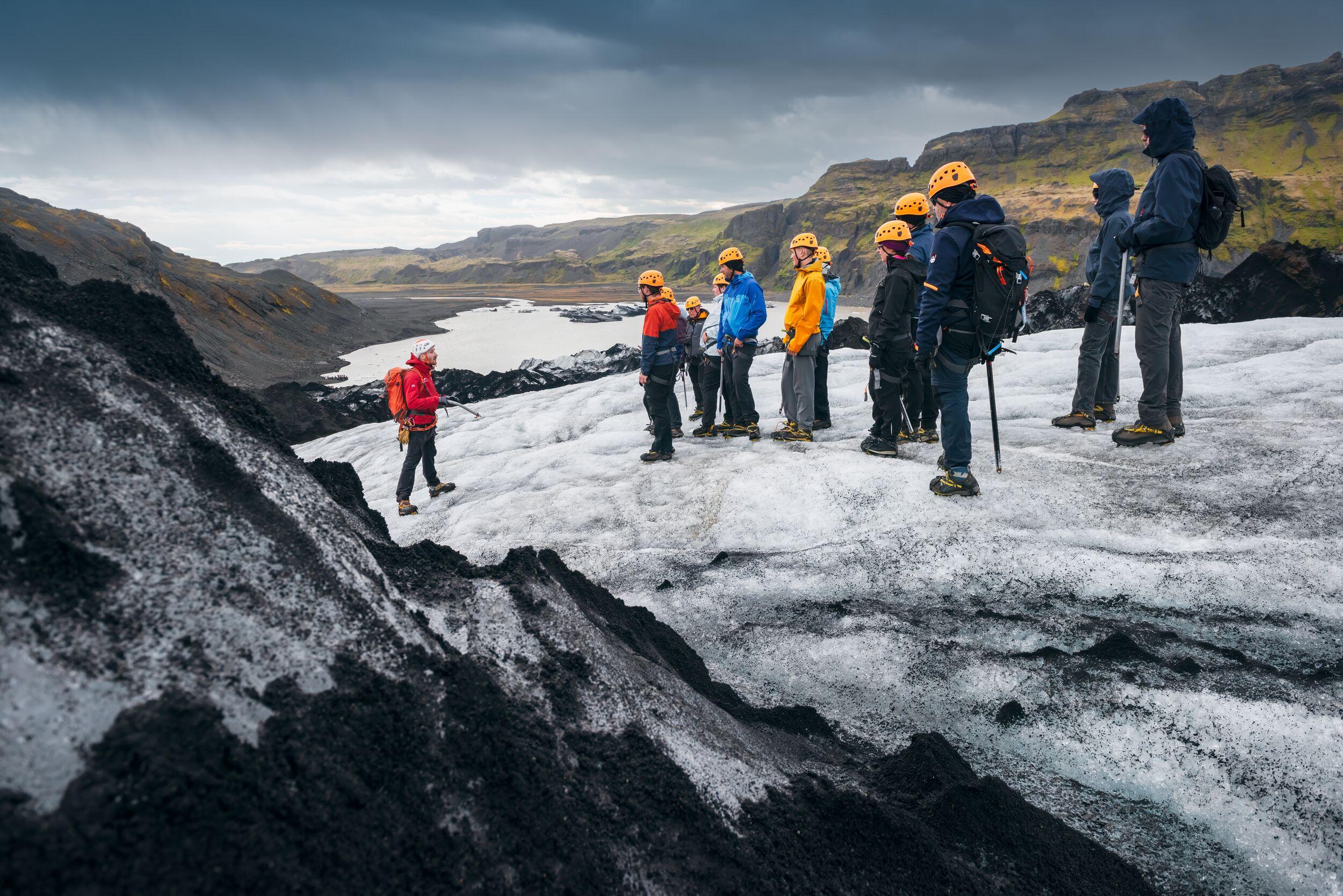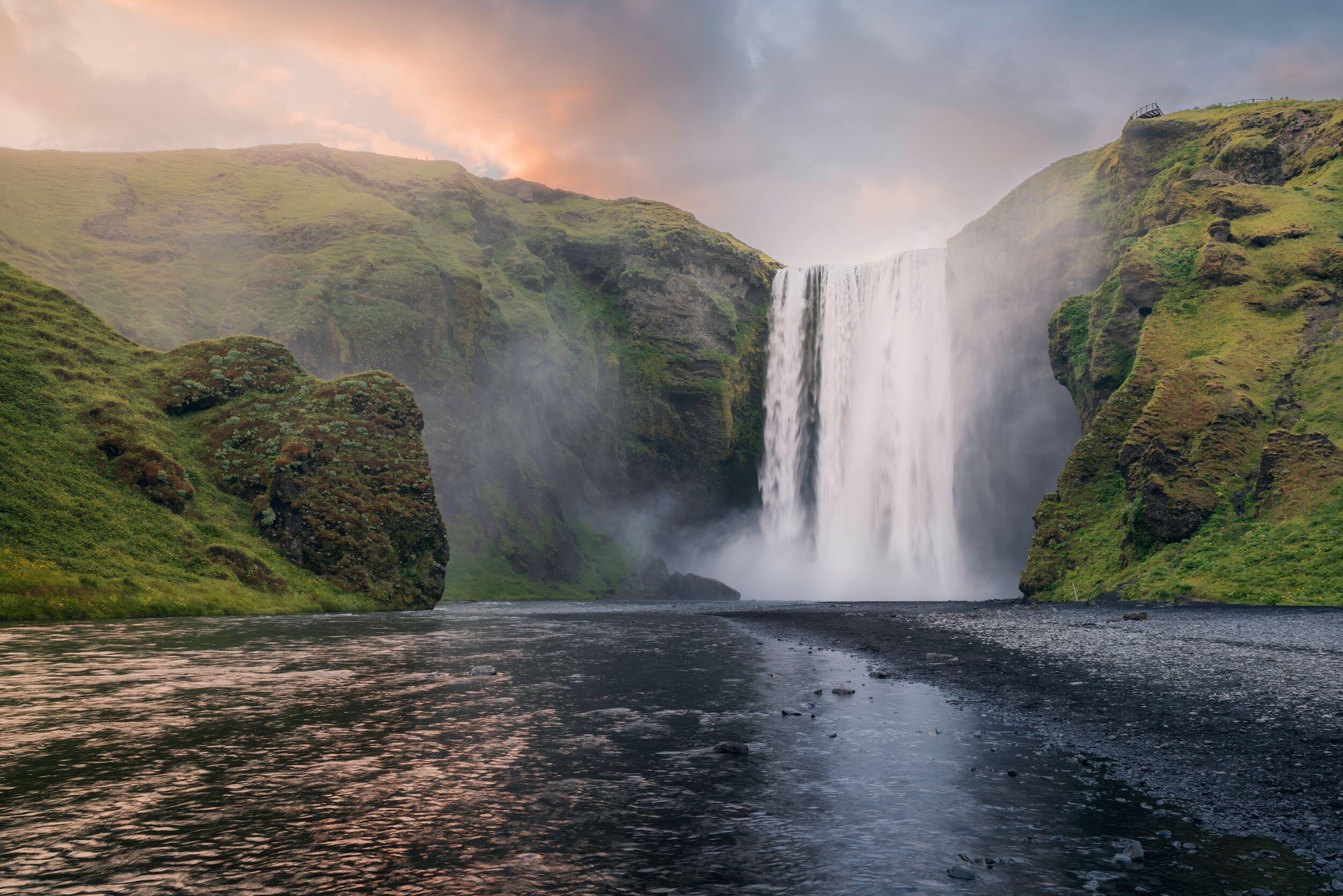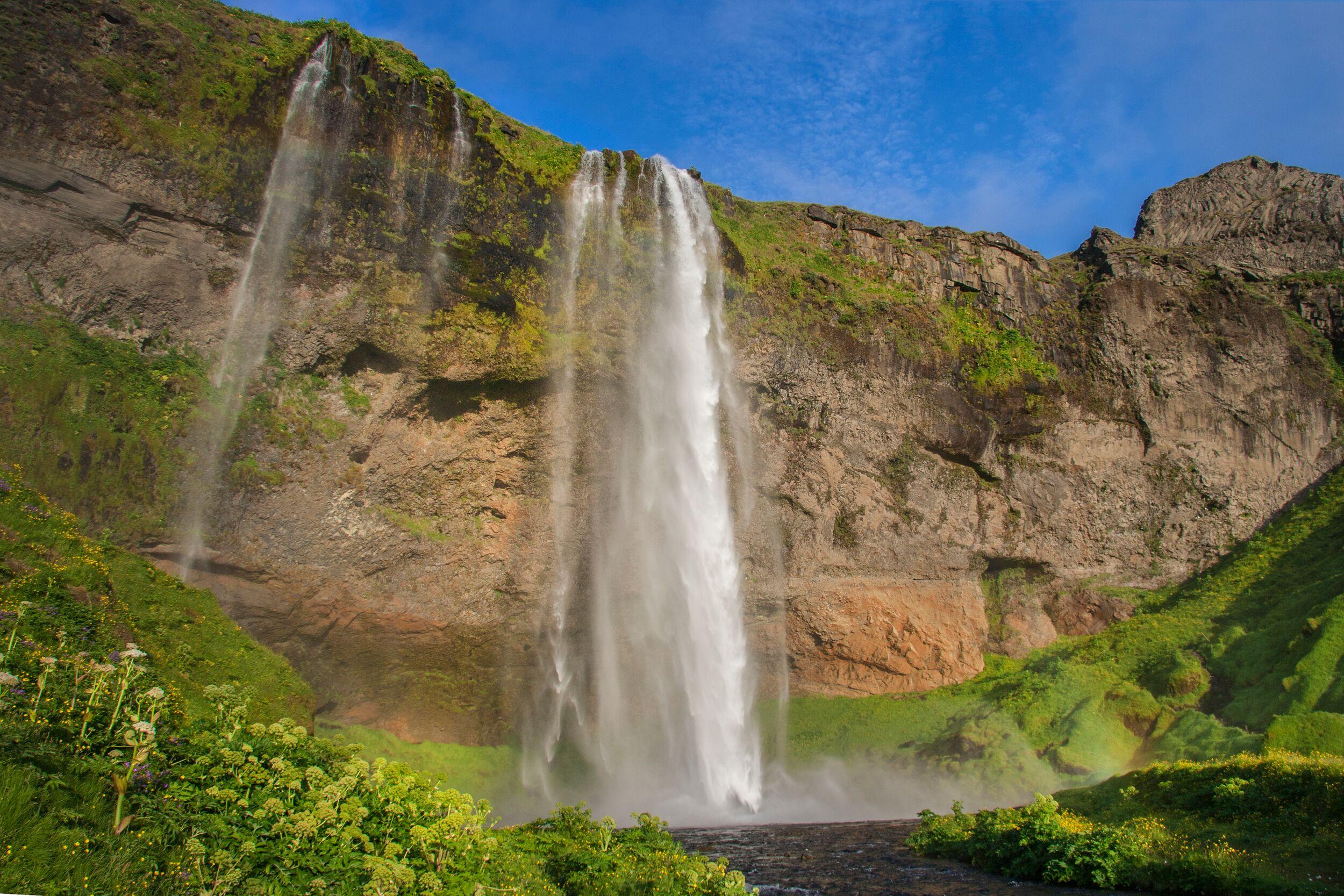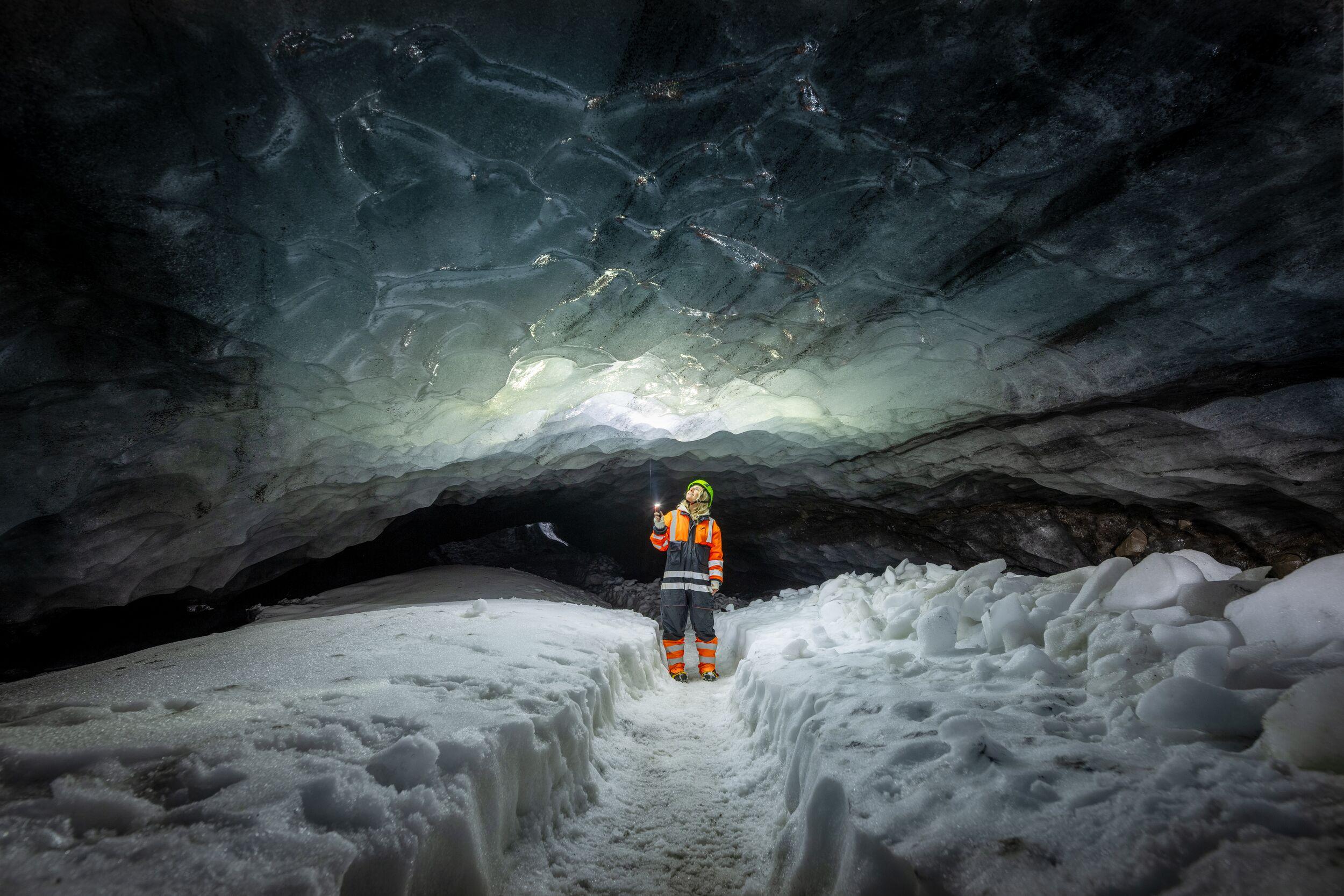
- Best time to visit
- All year round
- Coordinates
- 63.494609, -19.32828
- Distance from Reykjavík
- 165 km (101 mi)
The Askur Ice Cave nestled at the foot of the Mýrdalsjökull glacier, offers a captivating glimpse into the natural wonders of Iceland. This extraordinary ice cave is renowned for its unique features, including layers of volcanic ash from historic eruptions of the nearby Katla volcano.
The intricate natural patterns of the cave, the ash layers, and the bubbles trapped in the ancient ice create a mesmerising visual spectacle. Combined with the meditative sound of trickling meltwater streams, the Askur Ice Cave provides visitors with an otherworldly experience.
The Meaning of Askur
In Norse mythology, Ask and Embla (Old Norse: Askr ok Embla), male and female, were the first two humans created by the gods. The pair is attested in both the Poetic Edda, compiled in the 13th century from earlier traditional sources, and the Prose Edda, written in the 13th century by Snorri Sturluson. In both sources, three gods, one of whom is Odin, find Ask and Embla and bestow upon them various corporeal and spiritual gifts.
Mýrdalsjökull Glacier and Katla Volcano
Mýrdalsjökull, one of Iceland's largest and most majestic glaciers, spans an area of approximately 595 square kilometres. Beneath this vast ice cap lies the mighty Katla volcano, a geological giant that has shaped the landscape over centuries. Katla, one of Iceland's most active and formidable volcanoes, has a profound influence on Myrdalsjökull, with its periodic eruptions depositing layers of ash across the glacier.
Glaciers like Mýrdalsjökull are formed over millennia as snow accumulates year after year, compressing under its own weight to turn into dense, blue ice. The ice can be thousands of years old, preserving a history of past climates and geological events. The blue hue of glacial ice occurs because dense ice lacks oxygen and absorbs all colours of the light spectrum except blue, which is scattered and makes the ice appear vibrant.
The unique black ash layers testify to Katla's dynamic history. During eruptions, ash is spewed into the atmosphere, eventually settling on the glacier's surface. Over time, as new ice forms, these ash deposits become encapsulated within the glacier, creating distinct stratifications that can be seen within the ice caves. These ash layers not only tell the story of Katla's past eruptions but also add a striking visual contrast to the pristine blue ice, making the Askur Ice Cave a unique and fascinating destination.
The Features of Askur Ice Cave
A central path inside the Askur Ice Cave was carved out of the snow by our amazing Icelandic Mountain Guides, allowing visitors to explore the cave safely and comfortably. Small streams flow on either side of this path, creating soothing, meditative sounds that add to the cave's serene atmosphere.
When conditions are favourable, the cave features two openings: the main entrance and a moulin, a vertical shaft in the glacier. This moulin allows natural light to penetrate the tunnel, illuminating the ice and creating a magical, otherworldly ambience.
When the moulin is covered by snow, the tunnel becomes dark, but we light it with reflector lamps to highlight its beautiful features, including the intricate ice patterns, ash layers, and bubbles trapped in the ice.
The tunnel is quite deep, and depending on the conditions, we can walk about 100 meters into it, making it one of the longest ice tunnels discovered in Iceland. The impressive depth adds to the cave's sense of adventure and exploration.
The Color of the Askur Ice Cave
Many visit Iceland’s ice caves to see the vibrant blue glacial ice. Blue ice is created when dense glacial ice absorbs longer wavelengths of light (red, orange, yellow) and reflects shorter wavelengths (blue). The density and purity of the ice enhance this effect, giving it a vibrant blue colour. However, the perceived colour of the ice can vary depending on the conditions.
Sunny days enhance the blue hues, while overcast days or covered moulins make them less vibrant. The blue is more pronounced near the entrance, where natural light penetrates. The Askur Ice Cave is a long tunnel, so it is darker in the middle, making the blue less visible. Artificial lighting in darker sections reveals intricate patterns but doesn’t enhance the blue.
Volcanic ash layers from Katla’s eruptions add unique textures and contrasts, sometimes muting the blue. In summer, melting ice makes the ash more prominent, while winter light brings out more white and blue tones.
Visitors should have reasonable expectations as ice caves are natural formations. Their beauty lies in their pure, unpredictable state, offering a dynamic and ever-changing palette of colours for a unique visual experience.
Read more about this in our article about the Askur Ice Cave.
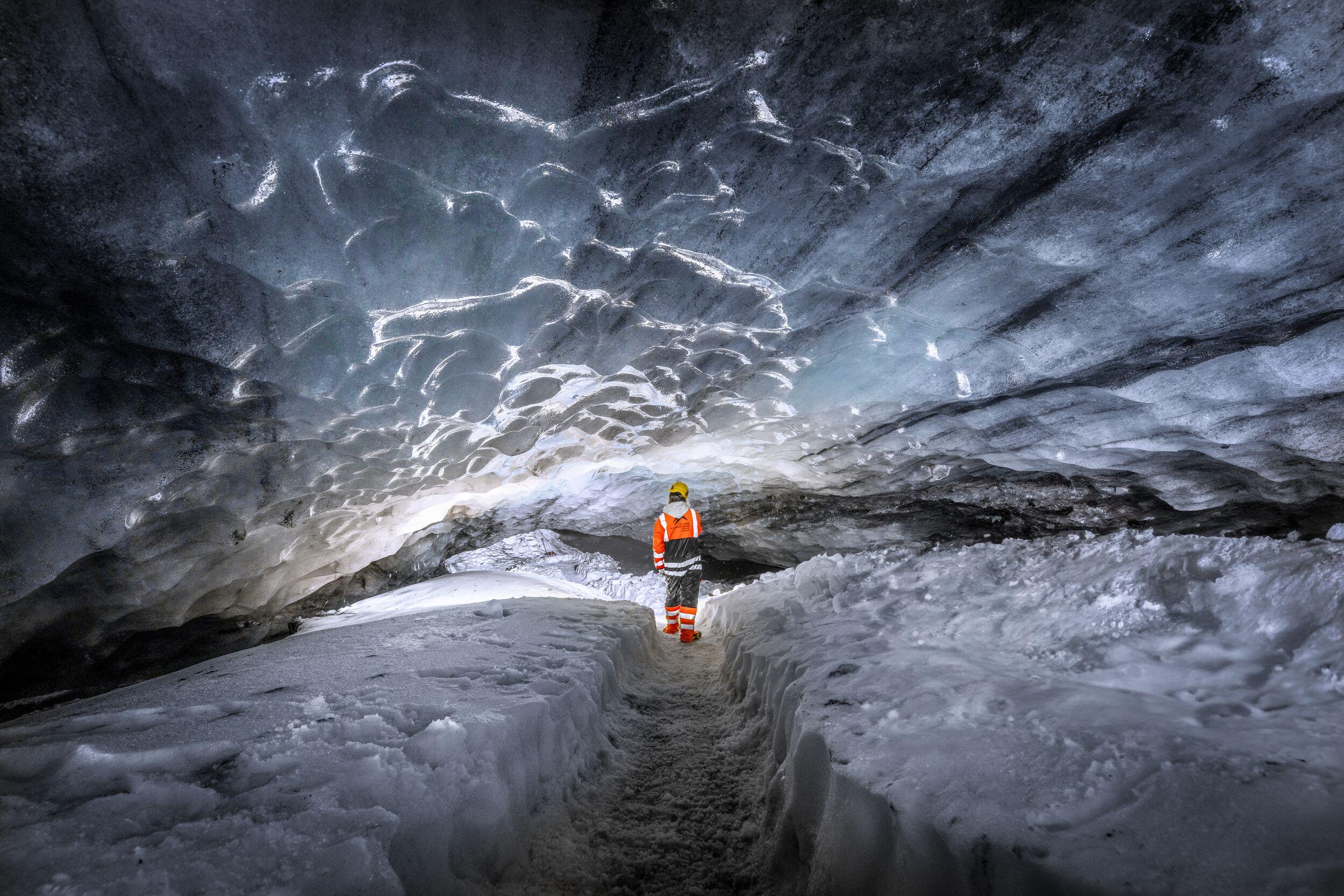
How Was Askur Ice Cave Created?
Meltwater is key in carving out the ice tunnel. During the warmer months, surface ice and snow melt, and the resulting water flows through cracks and crevices in the glacier. As this meltwater navigates through the glacier, it erodes the ice, gradually expanding these pathways into larger tunnels and chambers. This process is driven by both the volume of water flow and the pressure exerted by the water, which can carve intricate and expansive passages through the ice.
Over time, the continuous flow of meltwater creates the stunning features within the Askur Ice Cave. The water shapes smooth walls and ceilings, while the freeze-thaw cycles contribute to forming unique ice structures. The cave's internal landscape is further enhanced by the presence of ash layers from historic eruptions of the Katla volcano, which become embedded within the ice.
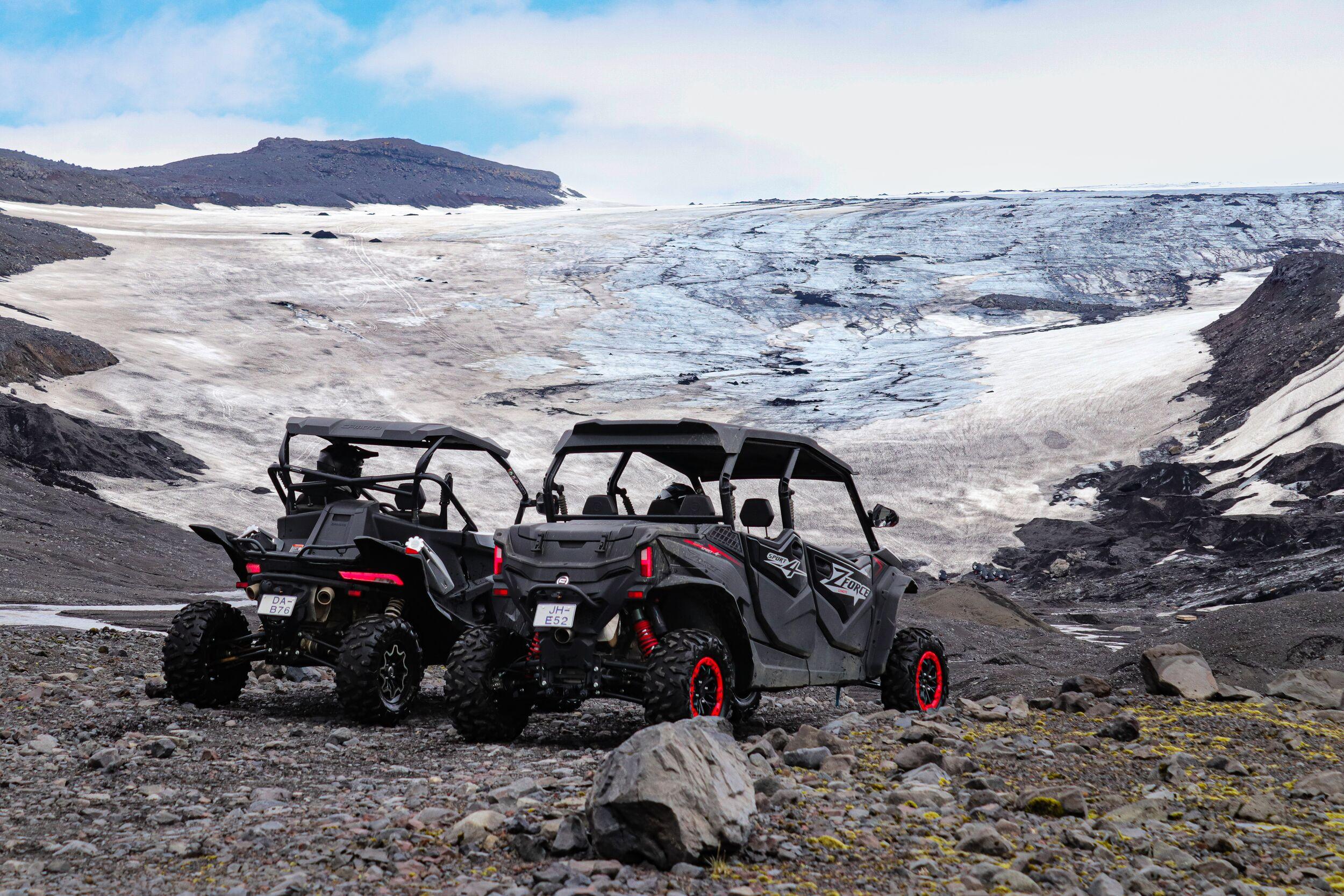
How to Access the Cave
The Askur Ice Cave is situated on private land, and members of the Icelandia family hold exclusive rights to visit it. This ensures that access is controlled and limited to our customers, maintaining the cave’s pristine condition and providing an exclusive experience.
Base Camp and Scheduled Tours
The Icelandic Mountain Guides operate a base camp near the glacier, from where scheduled tours to the Askur Ice Cave are organised. These tours are carefully planned to ensure safety and provide an enriching experience for all visitors.
The ultimate experience is the Askur Ice Cave Adventure tour. In summer and autumn, visitors travel to the ice cave by buggy. In winter, when conditions permit, a giant mountain truck takes you part of the way before switching to snowmobiles for the final leg of the journey. Each mode of transport offers its own unique thrill and adventure.
A lighter version of this adventure is the Askur Ice Cave in a Mountain Truck tour. You won't be driving the vehicle, but you'll travel aboard a mountain truck. This experience has a lower age limit, making it more accessible for families, but the highlight of the tour remains the same: the unforgettable visit to the ice cave.
Askur Ice Cave Tours from Reykjavík
For those starting from Reykjavík, we offer Adventure Bus tours that include carbon-neutral transfers to the base camp. These tours not only provide an eco-friendly way to visit the Askur Ice Cave but also include stops at some of Iceland’s most famous waterfalls, Seljalandsfoss and Skógafoss.
This makes for a full day of exploring Iceland’s natural wonders, combining the majesty of the ice cave with the beauty of the country’s iconic waterfalls.
The Askur Ice Cave offers a unique and mesmerizing experience that combines natural beauty, geological history, and adventure. The intricate ice patterns, layers of volcanic ash, and tranquil sounds within the cave create an atmosphere unlike any other.
Whether you choose the full adventure or the lighter mountain truck tour, the visit to the Askur Ice Cave will be an unforgettable highlight of your Icelandic journey.
Questions and Answers about Askur Ice Cave
The Askur Ice Cave is renowned for its unique features, including layers of volcanic ash from historic eruptions of the nearby Katla volcano. These ash layers, combined with intricate natural ice patterns and bubbles trapped in ancient ice, create a mesmerizing visual spectacle. The serene sound of trickling meltwater streams adds to the otherworldly experience, making it a truly unique destination.
The Askur Ice Cave was formed through the action of meltwater during warmer months. Surface ice and snow melt, and the resulting water flows through cracks and crevices in the glacier. Over time, this meltwater erodes the ice, expanding pathways into larger tunnels and chambers. The freeze-thaw cycles and the presence of ash layers from Katla's eruptions further enhance the cave's stunning internal landscape.
The Askur Ice Cave is situated on private land, and access is controlled by the tour providers within our Icelandia family. Tours are organised by the Icelandic Mountain Guides and depart from a base camp near the glacier. Depending on the season, visitors can reach the cave by buggy, mountain truck, or snowmobile. Scheduled tours ensure safety and provide an enriching experience while maintaining the cave’s pristine condition.
Tours to the Askur Ice Cave offer an adventurous and immersive experience. Inside the cave, guides carve out a central path, ensuring visitors can explore safely. The cave features a main entrance and a moulin (a vertical shaft) that allows natural light to illuminate the ice tunnel. Depending on conditions, visitors can walk up to 100 meters into the cave, marveling at its intricate ice patterns and volcanic ash layers.
The tour is much more than just an ice cave visit—it's a compact wilderness and adventure experience. Tour options vary by season, including thrilling buggy rides in summer and autumn, and exhilarating snowmobile rides in winter. For a more family-friendly option, mountain truck tours provide a comfortable yet adventurous way to reach the cave.
Tours from Reykjavík include stops at iconic waterfalls like Seljalandsfoss and Skógafoss, making it a full day of exploring Iceland’s natural wonders. Expect breathtaking landscapes, thrilling adventures, and a deep connection with Iceland's raw beauty.
In Norse mythology, Ask (or Askur) and Embla were the first two humans created by the gods. According to the Poetic Edda and the Prose Edda, three gods, including Odin, found Ask and Embla and bestowed upon them various gifts. The name "Askur" is deeply rooted in this mythological heritage, adding a layer of cultural significance to the cave's natural wonders.
As ice caves are a natural phenomenon, they’re very dependent on weather conditions. In the summer, when higher temperatures mean that glaciers retreat, ice caves aren’t always safe to enter. That’s why most ice caves are only available to visit during the winter, typically between mid-November and March.
That said, the man-made ice cave in Langjökull is open to visitors all year round.
Every ice cave has its particular character, quality, and magic. Perhaps the most impressive ice caves are those you’ll find in Vatnajökull, one of Europe’s largest glaciers. Thanks to their breathtaking forms and ever-changing shape, they promise an unforgettable experience.
That said, the man-made ice cave beneath the Langjökull glacier is an astonishing piece of engineering—and it’s open all year round.
There are many ice caves that you can visit in Iceland. But it’s always best to do it with a guide. As ice caves and glaciers more generally are always changing, you can only be sure that you’ll be safe if you’re led by a local expert.
The glaciers of Langjökull and Vatnajökull are where you’ll find most of Iceland’s best ice caves to visit.
Venturing into Iceland's ice caves without an expert guide is strongly discouraged. These awe-inspiring formations, nestled within the dynamic landscapes of glaciers, are not only hard to locate amidst the vast open ice and rugged terrain but are also subject to changing conditions that only local experts can accurately assess. It's crucial to understand that glaciers, in their majestic beauty, pose significant risks to those unfamiliar with their intricacies. With a knowledgeable guide, you can safely experience the mesmerising beauty of ice caves while ensuring your safety amid the glacier's ever-shifting environment.
Ice cave tours range in length, from quick visits to longer full-day experiences. The shortest tours last for an action-packed three hours including transport time, in which you can glimpse these icy caverns.
On a longer tour you can combine your ice cave visit with other experiences, such as a glacier walk, waterfalls, or a ride aboard state-of-the-art modified vehicles.
There’s a wide range of ice cave tours available in Iceland, each offering a different kind of experience.
One of the most popular options is to visit the Langjökull Ice Cave, beneath one of the deepest glaciers in Iceland. This is one of the world’s largest man-made ice caves, in an incredible remote location.
Alternatively, you can visit one of the natural ice caves formed when glaciers melt, twist, or change shape. Some of the most spectacular can be found in the Vatnajökull National Park.
As you might expect, Iceland’s ice caves are incredibly cold. They are formed of glacial ice after all!
That means that dressing warmly will be your top priority when taking an ice cave tour. Lots of layers, a warm jacket, and waterproofs are all highly recommended.
The other thing you shouldn’t forget are sturdy shoes. You’ll be walking on rugged, rocky terrain.
Ice caves are blue due to the way that light passes through the compressed ice of the walls. As the ice is very tightly packed, only blue light passes through it.
There are many ice caves in Iceland that claim to be the bluest ice cave in the country. However, you’ll see the blue effect no matter which ice cave you visit!
An ice cave tour in Iceland is truly a unique experience. How often do you walk beneath ice sheets or get up close to the mesmerising blue patterns in a wall of ice? On a visit to Iceland, a visit to an ice cave is definitely worth your time and money.
Why not combine your ice cave experience with a complete glacier tour? These landforms are one of Iceland’s most spectacular features.
Tours to the ice caves run throughout the day, and no matter what time of day you visit, they are always a beautiful experience. Choose a time that best suits your schedule.
Many of Iceland’s ice caves can be visited easily.
For example, you can visit the Langjökull Ice Cave onboard a specialised glacier vehicle that takes you right up to the entrance to the tunnel. Similarly, transport is available to take you to the Secret ice cave and the Aurora ice cave too.
If you’re up for more of a challenge, combine a visit to an ice cave with a glacier walk. This way, you’ll get the full experience of Iceland’s icy landscapes.
The closest natural ice cave to Reykjavík is the Askur ice cave at Myrdalsjökull, about two hours' drive from the city. Langjökull glacier, roughly two hours away, also has an ice cave, but it's man-made.



